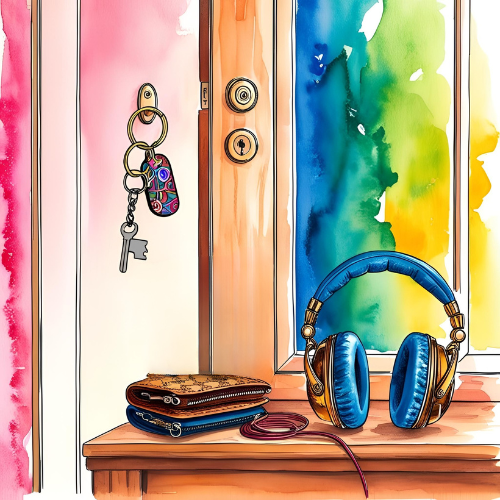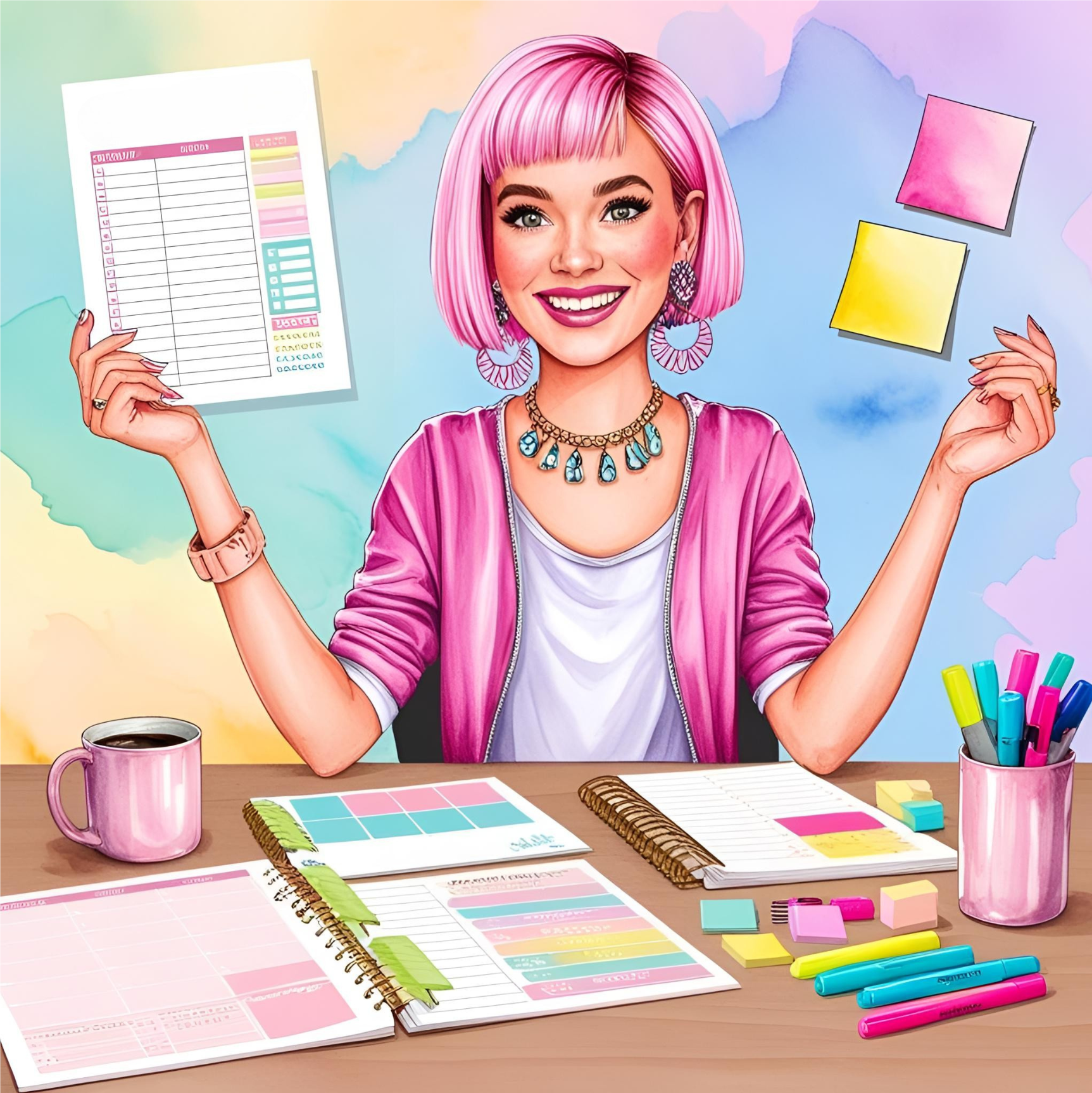Messy Brain? Try These Top ADHD-Friendly Organization Tricks
Visual Organization ADHD Tips That Actually Work
Ever feel like your brain is a cluttered desktop with 87 tabs open, 12 downloads in progress, and mysterious music playing from somewhere—but you can’t find the source? Yep. Same
If you have ADHD, “getting organized” can feel like an unreachable Pinterest fantasy. One minute you’re determined to KonMari your entire life, and the next thing you know, you’re deep in a Reddit thread about abandoned shopping malls.
But here’s the good news: you don’t need to be traditionally organized to function like a boss with ADHD. You just need tools that work with your brain—not against it.
In this post, we’re skipping the generic “buy a planner” advice and diving into visual organization ADHD strategies that are actually doable. Dopamine-friendly. Chaos-embracing. And tested by yours truly, an ADHD adult who has absolutely left her keys in the fridge.
ADHD Brains Crave
- Immediate rewards (hello, dopamine!)
- Visual cues (out of sight = out of mind)
- Flexible systems (rigid routines = rebellion)
- Novelty (because if it’s boring, it’s invisible)
Why Traditional Organization Doesn’t Work for ADHD Brains
Most traditional organizing advice is built for linear thinkers with consistent attention spans and a natural sense of time. ADHD brains? We’re more like jazz musicians on Red Bull—creative, spontaneous, and not super into predictable structure.
If color-coded bins and alphabetical filing systems make your eyes glaze over, you’re not lazy—you’re wired differently.
Trying to force ourselves into those one-size-fits-all organizing systems often backfires. We buy the planner. We label the folders. We spend hours setting up a gorgeous system that looks like something out of The Home Edit… and then abandon it two weeks later because it requires executive function maintenance we can’t reliably access.
It’s like being handed a beautiful tool kit for fixing a car… when your car is actually a spaceship, and the instructions are in Latin.
Here’s what usually goes wrong:
- Too many steps = we forget step one.
- Too tidy = we stop using it because we’re scared to “mess it up.”
- Too hidden = we forget it even exists.
- Too boring = our brains pretend it doesn’t exist.
That’s why your kitchen junk drawer makes more sense to your brain than a pristine, Pinterest-perfect filing cabinet. It’s accessible, chaotic, and somehow just works.
So instead of trying to “fix” your brain to match the system, let’s flip the script and build systems that match your brain– decluttering ADHD style.
Visibility is Vital: Make Things You Use Obvious
Ever bought something you already owned because it was “organized” into oblivion? Yeah… been there.
This post may contain affiliate links, including Amazon affiliate links. As an Amazon Associate, I earn from qualifying purchases. This helps support the blog—thank you!
Try the Detective Board Method
USet up your space like a crime drama evidence wall: use clear bins, open shelving, labeled pegboards, and color-coded zones. When your brain needs visual cues to remember what exists, tucking things away in opaque bins is like sending them into the void.
Tried-and-true visual organization ADHD hacks:
- A wall-mounted corkboard with “today,” “this week,” and “brain dump” zones
- A clear file sorter for active papers (because paper piles multiply like rabbits)
- Glass jars for art supplies, makeup, snacks, or tiny tech items
Make your space scream: “Look! This is where your stuff is!”
Bonus dopamine hit if it’s color-coded or aesthetic.
Create “Drop Zones” for Daily Chaos
Instead of aiming for minimalist perfection, accept that your life will get messy—and then design for it.

Enter: the Drop Zone
This is one of my most tried-and-true visual organization ADHD tips. A drop zone is a designated, judgment-free area for your daily clutter. It’s not just allowed—it’s expected. Decluttering ADHD homes requires creative problem solving, which is one of our biggest strengths!
Where to set one up:
- By the door (keys, wallet, sunglasses, receipts)
- By your bed (phone, book, meds, mystery hair tie)
- By your desk (mail, sticky notes, your seventh fidget cube)
Use trays, bins, or even cute baskets labeled with “dump here” or “future me will deal.” This lets your brain relax knowing the chaos has a home—and gives you one less thing to lose.
💡 Pro tip: Set a reminder once a week to declutter your drop zones. Think of it as “archiving the chaos.”
Time Isn’t Real (So Trick It)
ADHD time blindness is like living in a house with no clocks, no windows, and no sense of how long anything takes. Either it’s “now” or “not now.” So how do we organize tasks in a world where time doesn’t feel real?
🕒 Use Time Anchors + External Structure
Instead of relying on your internal clock, pair tasks with concrete external cues.
Try Habit Stacking:
- After brushing your teeth → wipe the bathroom counter
- After making coffee → check your top 3 priorities
- After feeding the pet → take your meds
Add timers, visual countdowns, or talking alarms. I use a kitchen timer shaped like a tomato (the ADHD holy grail: novelty!) and tell myself, “Just 10 minutes. You can quit after that.” Spoiler: I usually don’t.
Optional add-on: A visual timer or time-blocking printable you can actually see at your desk. I like ones that use colors or shapes instead of strict time slots.
Organize by Vibe, Not by Category
Forget the old “put like with like” rule. ADHD brains don’t think in spreadsheets—we think in vibes. We want things where we use them, not where Martha Stewart says they belong.
🧠 Try Task-Based or Mood-Based Zones
Instead of putting all cleaning supplies in a closet, try this:
- Bathroom wipes under the sink
- Counter spray in the kitchen
- Lint roller near your closet mirror
Or organize by vibe:
- A “cozy night zone” with fuzzy socks, face mist, and your current book
- A “leave the house” station with keys, gum, sunglasses, deodorant (yes)
- A “creative chaos bin” with ADHD-hobby-of-the-week supplies (mine has stickers, glitter glue, and half-finished crochet projects)
Why This Works for ADHD Brains 🧠
Let’s be real: traditional organizing systems are often built for brains with linear thinking, predictable attention spans, and working memory that doesn’t vanish mid-sentence. ADHD brains? We’re more like jazz bands during a thunderstorm—creative, dynamic, and often chaotic (in the best way).
So what actually works? Strategies that reduce cognitive load, offer visual cues, and reward your brain with little hits of dopamine.
Here’s the science behind why these ADHD organization tips actually work:
- Time blindness means we struggle to feel the passage of time, making it hard to plan or pace tasks. Using visual timers, habit stacking, and external structure helps anchor tasks to reality.
- Working memory is like our brain’s sticky note—and for ADHD folks, it falls off the fridge constantly. Clear bins, drop zones, and corkboards are tools to help us see what we’re supposed to remember.
- Executive dysfunction can make initiating or finishing tasks feel impossible. That’s why techniques like body doubling are game changers—they lower the mental barrier to starting and provide real-time accountability.
According to CHADD (Children and Adults with Attention-Deficit/Hyperactivity Disorder), these kinds of tools are particularly effective because they “compensate for weaknesses in attention, memory, and organization” by providing structure and externalization.
👉 Source: CHADD’s ADHD Daily Living Tips
The bottom line? Your brain isn’t broken—it just needs a system built around how it actually works.

💖 Need printable tools to boost these ADHD organization tips?
Visit the HyperFocus Tools page for ADHD-friendly downloads like:
- Brain dump sheets
- Visual to-do list templates
- Reward charts (yes, you deserve a gold star)
More Tips
Last month I created a “power basket” next to my couch. It has:
- My remote
- My meds
- My favorite pen
- Chargers
- A fidget toy
- A mini to-do pad
I used to lose these daily. Now I don’t. That tiny win? A total game-changer.
It’s not fancy. It’s not Pinterest-worthy. But it works. And that’s the whole point.
📝 Quick Wins Checklist
You don’t have to do everything at once. Taking small steps actually leads to quicker progress than powering through a shame cyclone.
✅Use open or clear storage
✅ Create a no-judgment drop zone
✅ Stack tasks onto existing habits
✅ Place items where you use them—not where they “should” go
✅ Use body doubling to get unstuck
✅ Celebrate every tiny win
Your brain is not broken. It’s brilliant. You just need systems that speak its language.
💬 From Shame Spiral to “I’ve Got This
Before I figured out these ADHD organization tricks, I had this dreamy (read: delusional) idea that I could transform my space with a label maker, some pastel bins, and an “everything in its place” mentality.
So I spent a weekend alphabetizing files, making Pinterest-worthy drawer dividers, and even labeling the snack shelf in the pantry. It was ✨aesthetic✨… for like, 3 days.
Then ADHD did its thing. I put one paper in the wrong place and suddenly the whole system felt “ruined.” So I stopped using it. Weeks later, I found my car keys inside the snack bin and a half-eaten granola bar in my file folder. Classic.
That’s when I tried setting up a drop zone—just one. No perfection, no rules. Just a basket near the door labeled “dump it here.” And guess what? I’ve actually been using it. No shame, no overwhelm. Just a tiny system that gives future-me a fighting chance.
If you’ve ever felt like your environment is a reflection of your failure, please know: it’s not. These decluttering ADHD organization tips are here to help you build systems that support your brain—not punish it.
Because organization isn’t about being tidy. It’s about finding what works for you—and letting go of the rest.




5 Comments